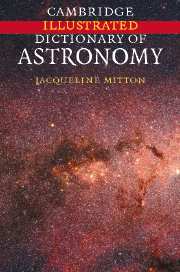Summary
UBV photometry A method of measuring the colors of stars introduced in the 1950s. It is based on measuring the ➤ magnitudes of stars in three regions of the spectrum called U (ultraviolet), B (blue) and V (visual), which are centered on wavelengths 350, 430 and 550 nm, respectively. More bands were added later to extend the scheme into the infrared. These are called R, I, J, H, K, L, M and N, ranging from 0.7 to 10.2 µm.
UFO Abbreviation for ➤ unidentified flying object.
UKIRT Abbreviation for ➤ United Kingdom Infrared Telescope.
UKST Abbreviation for ➤ United Kingdom Schmidt Telescope.
ultra-luminous infrared galaxy (ULIRG) A galaxy emitting exceptionally strongly in the infrared. ULIRGs were first detected by the ➤ Infrared Astronomical Satellite in 1983. They appear to be the results of collisions between two or more galaxies, which trigger immense bursts of star formation. The infrared radiation is emitted by dust, which absorbs energy from hot, newborn stars. Observations suggest that many ULIRGs are the mergers of three or more galaxies.
ultraviolet astronomy The study of electromagnetic radiation from astronomical sources in the wavelength band 10–320 nm. Ultraviolet (UV) radiation is strongly absorbed by Earth's atmosphere, so all UV observations have to be carried out from satellites. The earliest observations were made during brief rocket flights in the 1940s and 1950s. The first satellite to make systematic ultraviolet observations was the first Orbiting Solar Observatory (OSO-1) in 1962.
- Type
- Chapter
- Information
- Cambridge Illustrated Dictionary of Astronomy , pp. 361 - 367Publisher: Cambridge University PressPrint publication year: 2007



